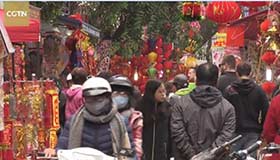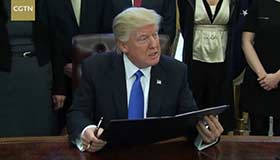SAN FRANCISCO, Jan. 29 (Xinhua) -- A University of California, Berkeley, researcher has described how to make and measure the properties of a crystal that have a structure that repeats in time, namely a time crystal.
Norman Yao, a UC Berkeley assistant professor of physics, has also predicted what the various phases surrounding the time crystal should be akin to the liquid and gas phases of ice in a paper published online recently in the journal Physical Review Letters.
While conventional crystals have an atomic structure that repeats in space, like the carbon lattice of a diamond, time crystals repeat in time because they are kicked periodically, sort of like tapping Jell-O repeatedly to get it to jiggle, Yao was quoted as saying in a news release from UC Berkeley.
The breakthrough, Yao argued, is less that these particular crystals repeat in time than that they are the first of a large class of new materials that are intrinsically out of equilibrium, unable to settle down to the motionless equilibrium of, for example, a diamond or ruby. "This is a new phase of matter, period, but it is also really cool because it is one of the first examples of non-equilibrium matter," he said. "For the last half-century, we have been exploring equilibrium matter, like metals and insulators. We are just now starting to explore a whole new landscape of non-equilibrium matter."
Two groups followed Yao's blueprint and have already created the first-ever time crystals. The groups at the University of Maryland and Harvard University reported their successes, using two totally different setups, in two papers posted online last year, both with Yao as a co-author.
Time crystals were first proposed in 2012 by Nobel laureate Frank Wilczek, and last year theoretical physicists at Princeton University and UC Santa Barbara's Station Q independently proved that such a crystal could be made. According to Yao, the UC Berkeley group was "the bridge between the theoretical idea and the experimental implementation."
The time crystal created by Chris Monroe and his colleagues at the University of Maryland employs a conga line of 10 ytterbium ions whose electron spins interact, similar to the qubit systems being tested as quantum computers. To keep the ions out of equilibrium, the researchers alternately hit them with one laser to create an effective magnetic field and a second laser to partially flip the spins of the atoms, repeating the sequence many times.
As the spins interacted, the atoms settled into a stable, repetitive pattern of spin flipping that defines a crystal.
Yao worked closely with Monroe as his Maryland team made the new material, helping them focus on the important properties to measure to confirm that the material was in fact a stable or rigid time crystal. Yao also described how the time crystal would change phase, like an ice cube melting, under different magnetic fields and laser pulsing.
From the perspective of quantum mechanics, electrons can form crystals that do not match the underlying spatial translation symmetry of the orderly, three-dimensional array of atoms, Yao said. This breaks the symmetry of the material and leads to unique and stable properties we define as a crystal. A time crystal breaks time symmetry. In this particular case, the magnetic field and laser periodically driving the ytterbium atoms produce a repetition in the system at twice the period of the drivers, something that would not occur in a normal system.
"Wouldn't it be super weird if you jiggled the Jell-O and found that somehow it responded at a different period?" Yao said. "But that is the essence of the time crystal. You have some periodic driver that has a period 'T', but the system somehow synchronizes so that you observe the system oscillating with a period that is larger than 'T'."














